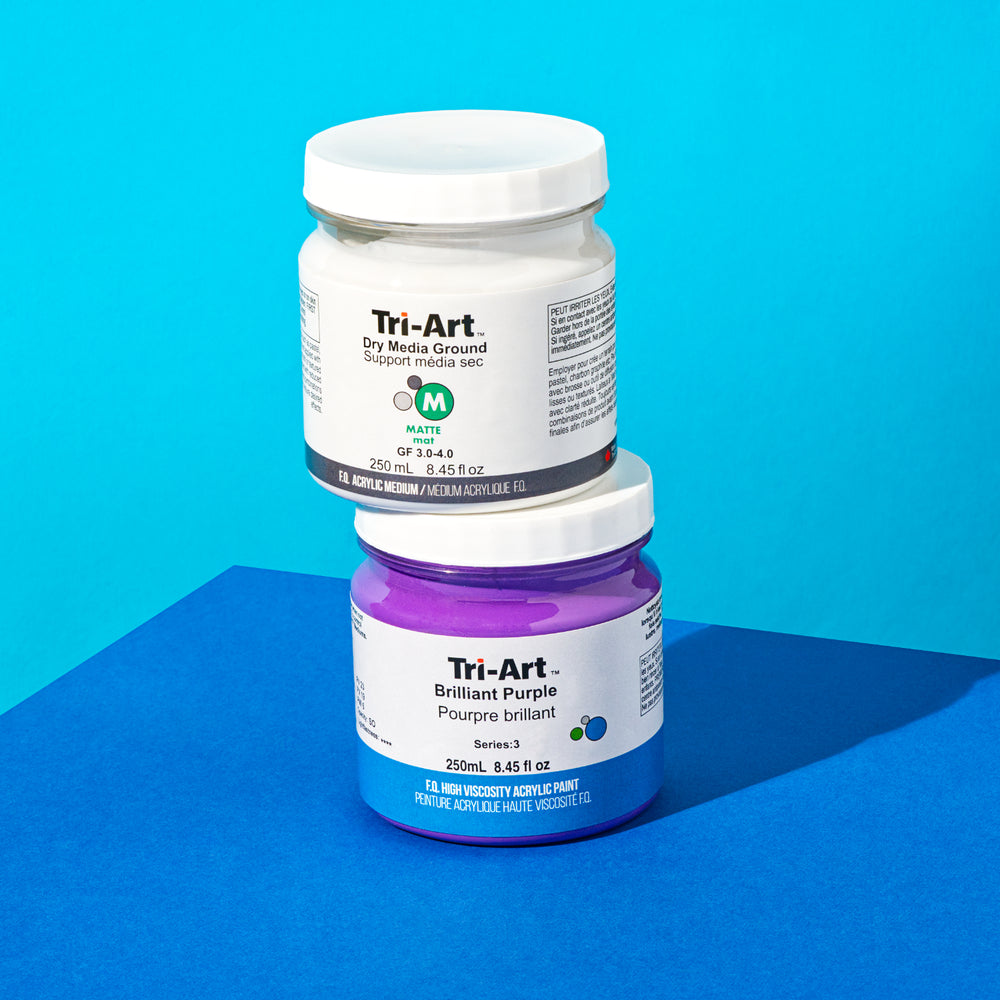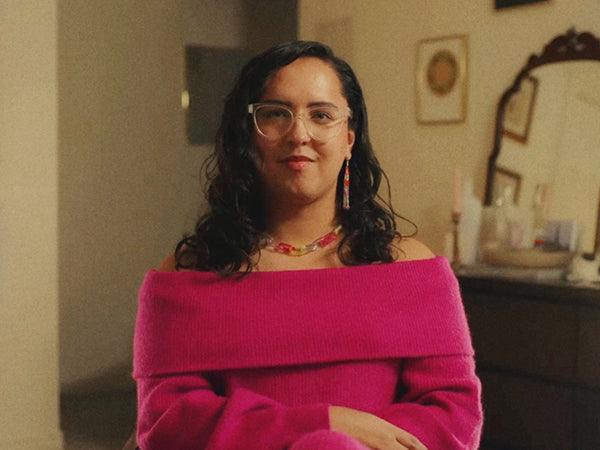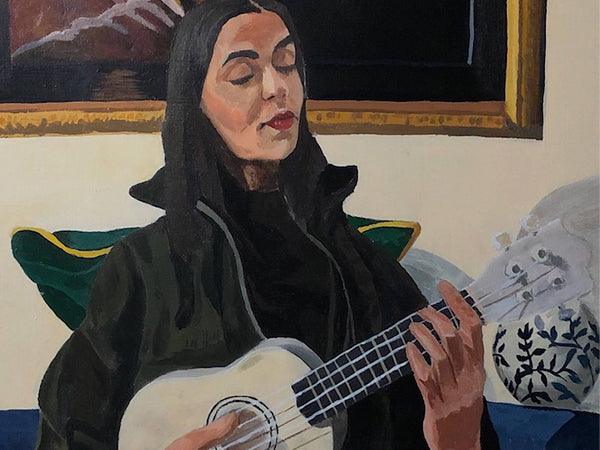
"I think if I spent all of my life in my home and not with anyone, I don't know that I would be doing art actually. I think the conversations and the connections with people is what pushes me to go into a little more of an introspective mode and then think and process through art."
Lifestyle & Personal Philosophy: How does your daily routine or lifestyle reflect your artistic philosophy or contribute to your creative process?
My daily routine is centered around two different things. One, I think I am, unfortunately, what people call a workaholic. I just love to be busy doing projects. That goes both for artistic stuff and also my day job tasks which are more centered around queer indigenous advocacy.
And then the second part of my life is really relationship centered and if I'm not with someone I'm preparing something for someone I love. I love trying to come up with care-centered ideas and things for people to make their life a little bit easier or spending time with my people. I think that translates into my work.
I end up either mindlessly doing art because it fits within my schedule or having conversations with people and having quality time with people. And then my art derives from those moments and those conversations and is fueled by it. A topic or an idea erupts from a moment with someone, like if we are really deep into dissecting a larger issue and it’s something that we're passionate about. Then I turn to art to expand on and explore those topics a little more.
I think if I spent all of my life in my home and not with anyone, I don't know that I would be doing art actually. I think the conversations and the connections with people is what pushes me to go into a little more of an introspective mode and then think and process through art.
I think it’s much more about the journey than the answers. I always say that I am not someone who has answers. I love to ask questions, but I never have the answer. I like to argue with people and debate and I've had people tell me like, why are you so opinionated? But I tell them I'm not opinionated. I'm pitching things out and arguing to see where we go together. It’s not like I’m having a strict opinion and I'm not budging… it’s just that I want to go further with an idea to see how it contrasts yours and what yours can bring to it. It’s about exploring and discovering.


Artistic Practice & Growth: Can you describe a pivotal moment or project in your career that significantly transformed your artistic practice?
It's so hard to select a singular moment. I think there’s probably around seventeen. Every project that comes along, well it’s like I get inebriated and then I just want to focus on it and work on it all the time. But I will say, I don't mean to sound vain, but recently that has been shifting.
My outlook on my practice has shifted particularly because of people recognizing me solely based on the art that I create. It's been very mind boggling to find out that this person I’m chatting with and getting to know is like, “actually I've seen your art,” or, “oh yeah, you're an artist in the community”. I say to myself, “this doesn't make sense!”
That’s really been changing my view on my art because I, as I said, I'm doing art for the relationship aspect and for the community aspect and to see that now without me having to be in spaces or to speak in those spaces, my art is creating connections and telling stories without me being there… It's really powerful. I think it's helping me invest more into it.
And it’s not about doing it to become famous or to become known, but I'm creating because it's building connections, it's building relationships, it's building community, and that's really exciting to me.
Sometimes it surprises me too because it’s not the type of people I would expect. It’s like, I don't know that I had you in mind when I created this piece of art, but the fact that you found something to connect with it is something I couldn't even have tried to do. I have cis white straight friends in my circle and I think about the fact that there's not many avenues for them to go past the stages of learning and unlearning by themselves in their living room or through reading a book about realities that they can't relate to, but through art and connection they have little avenues to get out in the world and have these conversations. If my art can be a way for those conversations to become more accessible to them then I'm happy that they have access to that and feel somewhat connected to my realities.


Activism & Justice: Could you share how you navigate the balance between activism and aesthetics in your art?
I connected with this question a lot. People ask me why I do art and most of the time I say, either I am using art as a means for storytelling like contributing to community or bringing awareness to emerging issues or communicating my experiences but the other part of it is that I just love beautiful things. I really love aesthetically pleasing things and it brings a feeling that is very soothing to me.
I walk through the world looking at graphic design and branding and I’m drawn to products because of the beauty of it. Of course that's a more capitalistic view but there's something to be said for the power of design and beauty in that way; the juxtaposition of design.
I often turn to creating beauty that is mindless or doesn't have a purpose sometimes other than the beauty itself. And I think that is why I'm someone who's very driven by a call for proposals or exhibitions because my work can be like creating without a brain but these exercises are like journaling prompts that then push me to make something in alignment with the themes and bring more intentionality.
So that balance between activism and aesthetics is very important because often when I give purpose to a piece, as I said, it's a purpose based in community and emerging issues and storytelling. There's definitely a dichotomy because everything is made out of my hands but becomes fueled by others.


Mediums & Experimentation: You work with many mediums. Do you have a favourite, and are there any new mediums or techniques you're eager to explore?
" I am using art as a means for storytelling, contributing to community or bringing awareness to emerging issues ... but the other part of it is that I just love beautiful things."
I know. It's just not fair. I think as a Sagittarius, overall a person that's driven by passion and by fire, my favorite medium is whatever my current obsession is.
Collaging has been very kind to me. And I've had an obsession with reflective papers and metallics. I think there's something that really calls me to it. I can’t even explain it. Bringing beadwork into my practice is something that's taken a lot of space lately and incorporating it with other mediums.
In the summer I asked myself, “how could these mediums live together?” and I had the chance to put that to the test with the Close to Home exhibition at the KSOA Window Art Gallery, where I made a collaged cube and a beaded cage for it and it was suspended.
In an upcoming project with a wonderful local artist, we're using textile with natural dyes and beading and creating a floating installation together. I'm still learning how beadwork makes sense for me and my love for textures and juxtaposition. It's very exciting because it's scary.
I will say, as someone who's learning to bead, with beading being such a traditional practice, it's always scary to turn a traditional practice that you're just reconciling with into part of your work. The act of bringing that into your world and shaping that in ways that make sense to you is challenging. There's a certain respect that needs to be taken to the approach. And I remember, I have an ex colleague, now a friend, who used traditional medicine to make a contemporary piece. The piece incorporated a conversation of positive and queer, inclusive sexual health conversation, and religious communities.
They received backlash from people saying, “you're using sacred medicine and making it about something that's not sacred”. I think it can be argued that sex and sexuality is very sacred to many people, especially and particularly in queer communities.
And so, I have a lot of respect for the approaches taken with bringing traditional knowledge and practices to a more contemporary practice. Kent Monkman, has a similar style with renaissance paintings that depict more accurate colonial scenes. Kent also brings a Two Spirited essence to each piece and incorporates queerness. I love to see the knowledge expressed and all of the stories being interpreted through a queer lens.

Dream Projects & Aspirations: Is there a dream project or collaboration you've always wanted to pursue?
I have two things. I studied fashion marketing and when I got into fashion marketing, my goal was to go into magazine editing. I have a collection of independent magazines from different countries and I just love print. I think that’s what I’ve translated into collaging.
That's one goal - to have an independent publication. And I think right now I’m also getting into writing projects. I have a current writing project to undertake. I find life just gets in the way and writing for me is something that's harder than any other form of art. I wish I had seven months to work on this and have nothing else on my brain. The project is all about caring for others through ruptures and community hardships. I want to have the space to dedicate the time for it, and create a piece that is informed by community, informed by my navigation of community, and I really can't wait for this project to make sense and come alive in my life.
Inspiration & Influences: Who or what are your greatest influences, and how do they manifest in your work? Also, can you touch on your thoughts about juxtaposition within what you create?
I don’t have a particular who but inspiration often comes through, as I said before, conversations and arguments, debates with friends or people in my community. For me it also often comes through music, particularly when it comes to collaging. I find house music, folk music and neo soul music are three genres I am very deeply tied to. And then house music, DJing, but then folk music convey very strong and powerful texts with soft sounds. There is this style that I love, which is composed of juxtaposing sounds and textures that, on their own, don’t seem like they would coexist well together, but I make sense of them.
And I think that translates to intersectionality and having life experiences, identities and living in systems that do not make sense or should not be a thing, but they are and you don't really have control over it.
I think it’s about these mixes of things that don’t really make sense, but end up creating something very beautiful. That's what I mean by juxtaposition.That’s the big source of inspiration for my art.

Community & Collaboration: How important is the artistic community or collaboration with other artists in your work, and can you share a memorable collaborative experience? Do you have upcoming collaborations you’d like to share?
I'm realizing the benefit of collaborating (not collaborating in a way that specifically means we're creating one piece together) sharing space can be while making art. I really enjoy creating next to someone that's creating something different. And often the conversations that come out of that are amplifying and adding to my work, both visually and thematically.
I love being connected through art with other people and it’s a very small arts community here in Kingston so you see the same people often. But I’ve had really great experiences.
Sometimes that connection aspect refers to bringing people's work together in a display or exhibition. People connecting the artists together in the community are doing important things.

Legacy & Future Impact: Looking forward, what kind of impact do you hope your work will have on future generations of artists or the wider public?
That’s a big question. There's a million things, once again, that I want to be able to highlight in my journey. And those things, well, I probably don't know what they're all going to be because they're going to be so relevant to whatever I'm going through. But there will definitely be themes of Indigenous rights to trans knowledge.
I want to explore non hierarchical ways of building relationships through art too. I want to create conversations about it. But one thing I keep coming back to, in recent years, is touching on accountability as a whole. I really hope that I can help facilitate larger conversations around accountability.
Because I think we are, as a community, deeply lost in how to deal with harm. And we're used to relying on systems that we now are becoming much more and more aware do not work. They're not meant for our well being and they're actually just meant to deal with things as quickly as possible which often takes humanity out of it.
Once again, I'm not someone who provides answers, but I hope that I can bring up the good questions, the important questions. I want to create work that leaves people ready and inspired to learn about what accountability is and seek better tools to know how to define it for yourself when you're dealing and facing harm and violence.
Right now we're in such a state of scarcity and of self preservation that we are making sure that the moment we perceive a risk for harm, we are shunning these things out and we're building barriers because the systems don't give us tools to deal with others and how to bring people in. We're just taught how to kick people out. I think that's the main thing that I want to continue to have conversations about. I want to discuss and get curious about how to love when you don't agree or how to care for each other in a way that benefits everyone.
"I want to explore non hierarchical ways of building relationships through art too. I want to create conversations about it. But one thing I keep coming back to, in recent years, is touching on accountability as a whole."




